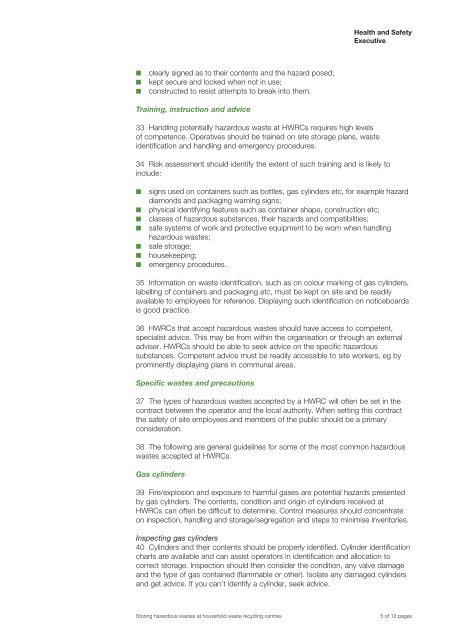Storing hazardous wastes at household waste recycling centres - HSE
Storing hazardous wastes at household waste recycling centres - HSE
Storing hazardous wastes at household waste recycling centres - HSE
You also want an ePaper? Increase the reach of your titles
YUMPU automatically turns print PDFs into web optimized ePapers that Google loves.
Health and Safety<br />
Executive<br />
■■<br />
■■<br />
■■<br />
clearly signed as to their contents and the hazard posed;<br />
kept secure and locked when not in use;<br />
constructed to resist <strong>at</strong>tempts to break into them.<br />
Training, instruction and advice<br />
33 Handling potentially <strong>hazardous</strong> <strong>waste</strong> <strong>at</strong> HWRCs requires high levels<br />
of competence. Oper<strong>at</strong>ives should be trained on site storage plans, <strong>waste</strong><br />
identific<strong>at</strong>ion and handling and emergency procedures.<br />
34 Risk assessment should identify the extent of such training and is likely to<br />
include:<br />
■■<br />
■■<br />
■■<br />
■■<br />
■■<br />
■■<br />
■■<br />
signs used on containers such as bottles, gas cylinders etc, for example hazard<br />
diamonds and packaging warning signs;<br />
physical identifying fe<strong>at</strong>ures such as container shape, construction etc;<br />
classes of <strong>hazardous</strong> substances, their hazards and comp<strong>at</strong>ibilities;<br />
safe systems of work and protective equipment to be worn when handling<br />
<strong>hazardous</strong> <strong><strong>waste</strong>s</strong>;<br />
safe storage;<br />
housekeeping;<br />
emergency procedures.<br />
35 Inform<strong>at</strong>ion on <strong>waste</strong> identific<strong>at</strong>ion, such as on colour marking of gas cylinders,<br />
labelling of containers and packaging etc, must be kept on site and be readily<br />
available to employees for reference. Displaying such identific<strong>at</strong>ion on noticeboards<br />
is good practice.<br />
36 HWRCs th<strong>at</strong> accept <strong>hazardous</strong> <strong><strong>waste</strong>s</strong> should have access to competent,<br />
specialist advice. This may be from within the organis<strong>at</strong>ion or through an external<br />
adviser. HWRCs should be able to seek advice on the specific <strong>hazardous</strong><br />
substances. Competent advice must be readily accessible to site workers, eg by<br />
prominently displaying plans in communal areas.<br />
Specific <strong><strong>waste</strong>s</strong> and precautions<br />
37 The types of <strong>hazardous</strong> <strong><strong>waste</strong>s</strong> accepted by a HWRC will often be set in the<br />
contract between the oper<strong>at</strong>or and the local authority. When setting this contract<br />
the safety of site employees and members of the public should be a primary<br />
consider<strong>at</strong>ion.<br />
38 The following are general guidelines for some of the most common <strong>hazardous</strong><br />
<strong><strong>waste</strong>s</strong> accepted <strong>at</strong> HWRCs.<br />
Gas cylinders<br />
39 Fire/explosion and exposure to harmful gases are potential hazards presented<br />
by gas cylinders. The contents, condition and origin of cylinders received <strong>at</strong><br />
HWRCs can often be difficult to determine. Control measures should concentr<strong>at</strong>e<br />
on inspection, handling and storage/segreg<strong>at</strong>ion and steps to minimise inventories.<br />
Inspecting gas cylinders<br />
40 Cylinders and their contents should be properly identified. Cylinder identific<strong>at</strong>ion<br />
charts are available and can assist oper<strong>at</strong>ors in identific<strong>at</strong>ion and alloc<strong>at</strong>ion to<br />
correct storage. Inspection should then consider the condition, any valve damage<br />
and the type of gas contained (flammable or other). Isol<strong>at</strong>e any damaged cylinders<br />
and get advice. If you can’t identify a cylinder, seek advice.<br />
<strong>Storing</strong> <strong>hazardous</strong> <strong><strong>waste</strong>s</strong> <strong>at</strong> <strong>household</strong> <strong>waste</strong> <strong>recycling</strong> <strong>centres</strong><br />
5 of 12 pages

















